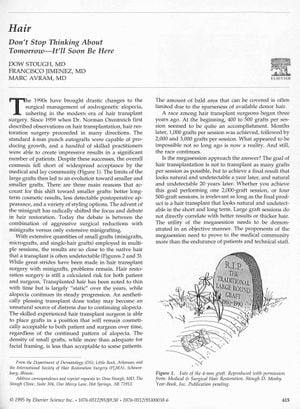Hair
May 1995
in “
Dermatologic Surgery
”

TLDR Smaller hair grafts in transplants offer better cosmetic results and more styling options, but challenges like thinning and limited coverage remain.
In the 1990s, hair transplant surgery for androgenetic alopecia underwent significant changes, moving away from the use of standard 4-mm punch autografts towards smaller grafts, including minigrafts, micrografts, and single-hair grafts. These smaller grafts provided better long-term cosmetic results, less detectable postoperative appearance, and more styling options. The debate in hair restoration shifted to whether to combine surgical reductions with minigrafts or to use extensive minigrafting alone. While the use of extensive quantities of small grafts in multiple sessions has led to results that closely mimic native hair and are often undetectable, challenges remain, such as the risk of thinning transplanted hair over time and the limited amount of bald area that can be covered due to sparse donor hair. The trend towards larger sessions, or "megasessions," has grown, with surgeons achieving up to 3,000 grafts per session. However, the goal remains to achieve a natural and undetectable result in both the short and long term, rather than simply transplanting as many grafts as possible. The document also discusses the evolution of other hair restoration techniques, such as scalp reductions, scalp lifting, and scalp extenders, and notes the high level of training required for new surgeons in this field. Innovations in instrumentation and potential future research areas, such as graft viability after freezing and the use of finasteride, are mentioned. The document emphasizes the ongoing challenge of predicting long-term male pattern baldness and the calculated risk involved in hair restoration surgery.